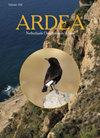Time Shift in the Exploitation of Fish Stocks by Great Cormorants Phalacrocorax carbo at Lake IJsselmeer: How Wintering Birds began Competing for Fish with Breeding Conspecifics
IF 1.3
4区 生物学
Q3 ORNITHOLOGY
引用次数: 1
Abstract
Monthly aerial bird counts showed a strong increase in the number of wintering Great Cormorants Phalacrocorax carbo sinensis since the late 1990s at Lake IJsselmeer but not at Lake Markermeer-IJmeer. Compared to the 1980–1990s, breeding numbers also increased in this part of the system. The resulting increased exploitation of fish stocks was thought to have been possible because of a long-term increase in the stock of Ruffe Gymnocephalus cernuus, despite a clear overall decline of total estimated fish biomass in the lake during the same period. The most likely cause of these shifts was thought to be the intensive commercial fishing regime, removing the large predatory fish first, followed by a strong reduction of stocks of large Bream Abramis brama, in turn paving the way for increases in the stocks of Ruffe. Increased predation by Cormorants on the enhanced stocks of small fishes was possible because of ameliorated underwater visibility in Lake IJsselmeer. Starting in 2000, there was a strong shift in both temporal habitat use and associated fish consumption by Cormorants towards the winter period. The local breeding birds, exploiting the same age- and size-structured community of fishes in the spring, thus face an already-depleted food resource. Compared to the 1980–1990s, fish consumption by Cormorants in winter increased by a factor of ten, whereas that by breeders did so by a factor of 1.6. Our calculations showed that the actual harvest of available fish stock by wintering and breeding Cormorants together was c. 5% in 1985–2000 and c. 15% in 2001–2015. The disproportionate division of the overall consumption (‘harvest’) of the fish stock towards the wintering birds is a strong argument for direct competition with their conspecifics breeding locally. In conclusion, we calculate that because of the increased winter exploitation initiated by the activities of an intensive commercial fishery, the fish consumption in summer and early autumn by breeding Cormorants and their offspring was suppressed by a factor of six.IJsselmer湖大Cormorants Phalacrocorax carbo开发鱼类种群的时间变化:越冬鸟类如何开始与繁殖特定物种竞争鱼类
自20世纪90年代末以来,IJsselmeer湖的越冬大鸬鹚(Phalacrocorax carbo sinensis)数量显著增加,而Markermeer-IJmeer湖的越冬大鸬鹚数量没有显著增加。与20世纪80 - 90年代相比,这部分系统的繁殖数量也有所增加。尽管同一时期湖泊鱼类总生物量的估计总体上明显下降,但由于长时间的增加,对鱼类资源的开发有可能增加。这些变化最可能的原因被认为是集约的商业捕捞制度,首先清除大型掠食性鱼类,然后大型布拉马鱼的数量大幅减少,反过来为布拉马鱼的数量增加铺平了道路。由于艾瑟米尔湖水下能见度的提高,鸬鹚对小鱼的捕食增加了。从2000年开始,鸬鹚在冬季对栖息地的使用和相关鱼类的消耗都发生了强烈的变化。当地的繁殖鸟类,在春天利用相同年龄和大小结构的鱼群,因此面临着已经耗尽的食物资源。与20世纪80年代至90年代相比,鸬鹚在冬季的鱼类消费量增加了10倍,而繁殖者则增加了1.6倍。我们的计算表明,在1985-2000年和2001-2015年期间,通过越冬和繁殖鸬鹚的实际渔获量分别为c. 5%和c. 15%。鱼类资源的总体消费(“收获”)不成比例地分配给了越冬鸟类,这是与它们在当地繁殖的同种物种直接竞争的有力论据。综上所述,由于集约化商业渔业活动导致冬季捕捞增加,繁殖鸬鹚及其后代在夏季和初秋的鱼消费量被抑制了6倍。
本文章由计算机程序翻译,如有差异,请以英文原文为准。
求助全文
约1分钟内获得全文
求助全文
来源期刊

Ardea
生物-鸟类学
CiteScore
2.10
自引率
0.00%
发文量
49
审稿时长
>12 weeks
期刊介绍:
Ardea is the scientific journal of the Netherlands Ornithologists'' Union, and is published since 1912. The journal welcomes manuscripts reporting significant new findings in ornithology, in particular those covering the ecology, life history, and evolution of birds, and including sound descriptive work. Ardea publishes Original research papers, Short notes and Book reviews. In addition to the regular three issues per year, Ardea publishes specials that contain conference or workshop proceedings (produced on request).
 求助内容:
求助内容: 应助结果提醒方式:
应助结果提醒方式:


